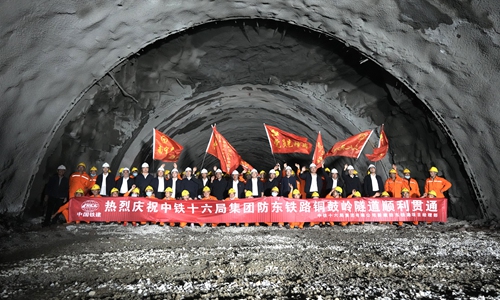
Workers congrats cut-through of the tunnel. Photo: Courtesy of China Railway Nanning Group Co
Constructions for a high-speed railway in South China's Guangxi Zhuang Autonomous Region that would allow Chinese high-speed trains to reach the China-Vietnam border have made major progress, as all the tunnels have been drilled through.
Once completed, the railway, which connects cities of Fangchenggang and Dongxing located at the China-Vietnam border, will play a major role in railway connectivity between China and members of the Association of Southeast Asian Nations (ASEAN).
Overall construction is estimated to be 79 percent complete. Once the line is operational, travel time between Fangchenggang and Dongxing will be shortened from 90 minutes to 20 minutes.
Zhou Shixin, director of the Institute for Foreign Policy Studies at the Shanghai Institutes for International Studies, told the Global Times on Wednesday that the construction of the railway will play an essential role in enhancing trade between China and Vietnam, as well as China and ASEAN.
"Dongxing has both land and marine ports, and the high-speed railway will provide another valuable opportunity for China's southward development strategies," said Zhou.
The 46.9-kilometer high-speed railway is designed to run at a maximum speed of 250 kilometers per hour. The line will have eight tunnels and 21 bridges. It will also be the first railway for Dongxing, which is the only city in the region that connects to ASEAN via both land and marine routes.
The number of cross-border freight trains from Guangxi to Vietnam reached 1,496 in the first 10 months of the year, increasing 57.5 percent year-on-year, according to China Railway Nanning Group. Of the freight trains, 272 were container trains, up 112.5 percent year-on-year.
Zhou said that the Fangchenggang-Dongxing railway will be mutually beneficial for both China and Vietnam. "The construction of the railway may fix the imbalance of Vietnam's development through trading with China," he said.
In addition, the Vietnamese government had been considering improving its domestic railway system by importing high-speed railway technologies from various sources, including China, France, Germany and Japan, but the plans was postponed by the global COVID-19 pandemic, according to Zhou.
"China's high-speed railway technology is a powerful competitor among its rivals, and the successful operation of the Fangchenggang-Dongxing railway along the border may increase Chinese high-speed railways' competitiveness," said Zhou.
The high-speed railway could also help boost already booming trade and exchanges between China and ASEAN countries, analysts said.
According to the Chinese General Administration of Customs, trade between China and ASEAN reached 4.55 trillion yuan ($712 billion) in the first 10 months of the year, up 20.4 percent year-on-year, and trade between China and Vietnam reached 1.21 trillion yuan, the biggest among ASEAN members.




